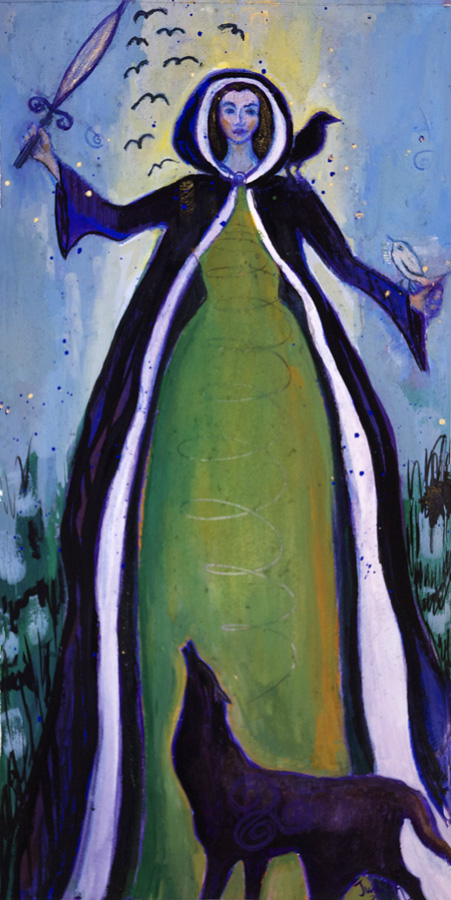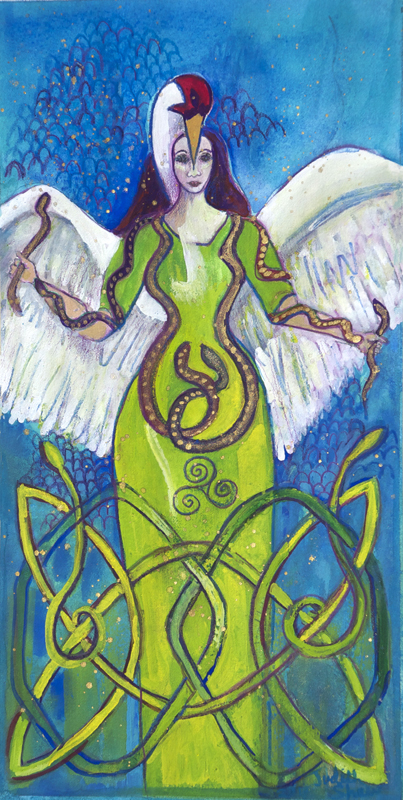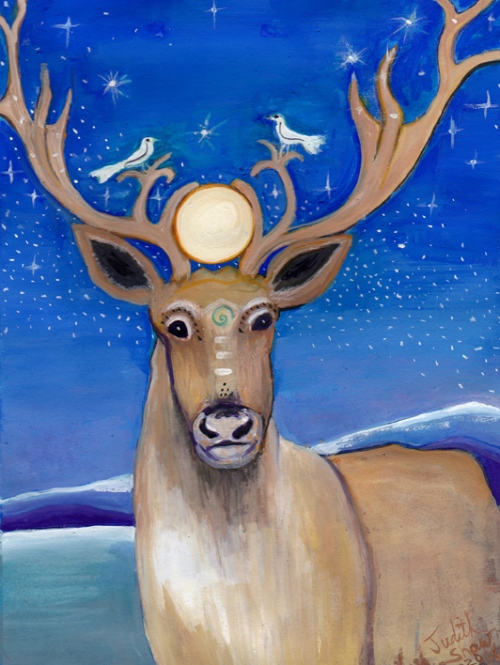From the mists of Welsh mythology Celtic Goddess Branwen provides important wisdom for our modern world. Themes of the destructiveness caused by viewing those different from us with distrust and fear are found in her story. Vengeance is revealed as a downward spiral of pain and suffering. She illustrates the healing role empathy and compassion for those different from us and forgiveness for those who have wronged us can play in a world gone mad with war.
Branwen was the sister of the giant, King Bran of the Isle of the Mighty. She was loved by her people for her gentleness, compassion and beauty. In the tradition of the Old Tribes of the British Isles, the son of the sister of the current king would become the new king upon the death of the old one. Thus Branwen is the embodiment of Sovereignty. She is the Center from which all life emerges. She rules over both the spirit of and the physical manifestation of the Land. Her vision is long, seeing the whole, the greater scheme of things.
Branwen is most likely a proto-Celtic Goddess, whose name means “White Raven.” Her story, as told in the Welsh compilation of stories, The Mabinogian, began with love.
The Irish King Matholuch came to call and a new course was set for both the Island of the Mighty and Ireland. He had come seeking marriage with Branwen. Never before had a woman of the old tribes left her people to marry a foreigner. And foreigners were often feared.
Matholuch was given permission to land. Branwen was called for. A feast was prepared and the two fell in love. Though Branwen dreaded the thought of leaving her people, she was in the grip of first love. But Matholuch, though also in the heat of first love, never lost sight of the fact that Branwen was the gateway into the world of kings to come. In his mind their son would rule both Ireland and the British Isles thus extending the power of his own legacy.
An agreement was reached and the marriage took place. The marriage feast lasted for many days. Night after night Branwen and Matholuch shared the fire of their growing love.
But trouble was brewing as one of Branwen’s four brothers, Eynissyen had been away during this time. He, a hot-headed troublemaker, became angry to not have had a voice in the decision. In his anger he sought a way to harm the Irish and violently maimed their beloved horses.
Evnissyen’s act of terror caused an uproar and threatened war between the two peoples. Bran and his brothers knew that the only true atonement in the eyes of the Irish would be the death of Evnissyen in retribution for the Irish loss. But this they could not do as it violated the very essence of the way of the Old Tribes — ways that sought resolution to conflict without blood vengeance.
So instead, Bran offered Matholuch a face-price — a monetary reparation such as had never been offered before. An agreement was reached. But seeing that Matholuch was still uneasy, Bran offered yet another boone — the cauldron of rebirth. Any warrior killed could be thrown into this cauldron and would emerge to fight again. Bran warned Matholuch that a wise king would not use this cauldron as these unearthly beings can do nothing but fight and cause total destruction. Unfortunately Matholuch was not a wise man.
And so Branwen sailed to Ireland with her man and they were happy for a few years. The people were dazzled by her beauty and charm. Their son, Gwern, was born. Matholuch felt sure his plan for his son to become king of both lands was well underway.
Up to this point, news of the maiming of the Irish horses had not reached the ears of the Irish people as the High Druid had forbidden the warriors to speak of the incident. But the High Druid died when Gwern was a baby and men’s tongues loosened with news of the insult. The Irish were furious at not getting blood vengeance. Ultimately they demanded that the King put Branwen aside and punish her for her brother’s sin — the wrong committed by a foreigner. And he, coward that he was, acquiesced to their demands, sending her to work in the hot kitchen.
For three years Branwen was alone, without a friend in the world. She endured shame and daily beatings. Finally one day she found a wounded baby starling. Approaching the starling with concern, an idea hatched in her mind and hope was reborn. She nursed the starling back to health and slowly taught it how to deliver a message to her brother, King Bran.
Finally the time arrived for the starling to fly. Branwen released her friend into the air who flew away across the sea to the Island of the Mighty.
It was a long and terrifying journey but finally the starling reached its destination. It found Bran and spoke the words Branwen had taught it.
Horrified at the news, Bran amassed the men of Wales and set out across the water to free Branwen.
Upon their arrival, and due to Branwen’s urgings for a peaceful settlement, Branwen’s release was negotiated. The face-price for peace was that Branwen’s son, Gwern would be the Irish High King and the building of a house large enough to house King Bran, a giant among men.
But once again Evnissyen, the hot-headed brother, intervened with catastrophic results. During a celebration of the peace, Evnissyen threw Gwern into the fire, killing him before anyone could react.
War broke out between the two peoples that destroyed them both. At the end of that day many lay dead but worse was yet to come. The Irish, hot with blood lust and vengeance, made the fateful decision to use the cauldron of rebirth to obtain demon warriors. Terrible battles raged and it seemed that all was lost.
Evnissyen finally accepted responsibility for all that had arisen. He sacrificed himself by going into the cauldron alive and breaking it apart from within. Toxic fumes engulfed all and by morning everyone was dead, save those sheltered in the Irish Halls of Tara and the newly constructed House of Bran.
Bran sent word to the Irish that they would leave the island on the morrow to what peace and reconstruction could be had. Treachery and vengeance once more reared its ugly head as the remaining Irish warriors ambushed the remaining Welsh, ultimately delivering a death blow to Bran with a poisonous spear. Bran, not wishing to endure a lingering death asked his brother to cut off his head and carry it back to Wales.
Branwen could endure the pain no longer. She died of a broken heart at the disastrous results of her call for rescue. Only seven men returned to the Isle of the Mighty, accompanied by the magical, talking head of Bran.
The story of Branwen, Goddess of Love and Beauty is truly one of sorrow. But love infuses her story from beginning to end. Through love she seeks to unite the two lands and its peoples. With empathy and compassion, she forgives and continues to seek peace even after her years of suffering and the murder of her son. Yet these qualities do not include excusing the offender — Branwen finally shut Matholuch out of her heart forever.
Branwen is a beacon, lighting the way for us all through dark feelings of hatred and vengeance. She leads us to a bright land with hearts full of empathy, compassion, love and forgiveness.
Though the places and peoples involved have changed since those long ago days in the British Isles, the same problems persist. The time is well over-due to end the cycles of retribution — a system of justice that could ultimately destroy the whole world. With empathy, compassion and forgiveness we can find a path to restorative justice.
Judith’s Celtic Goddess Oracle Deck is available. Click here.













